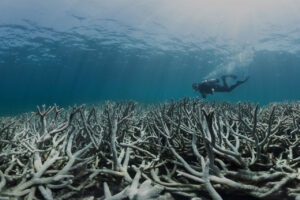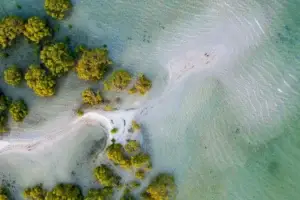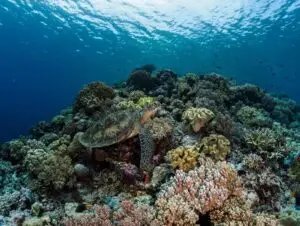by David Freedman Coral Reef Conservation and Biodiversity Awareness | Early Career Ocean Professional (ECOP)
Traditionally reliant on donations and grants, NGOs are exploring venture capital, impact investing, and other innovative financial models to secure funding. This article outlines how NGOs can finance their growth through sustainable funding methods using different steps throughout their journey, with specific metrics, and hypothetical scenarios to guide their journey.
Step 1: Aligning Organizational Impact with Investor Goals
Before seeking capital, NGOs must ensure their mission aligns with investor goals. Impact investors, venture capitalists, and development banks often prioritize returns, not just in financial terms, but also in ecological and social impact.
Key Metric: Impact Return on Investment (IROI)– This metric measures the positive environmental and social impact created per dollar invested. NGOs should calculate the IROI by quantifying the ecological outcomes of their projects (e.g., hectares of marine protected areas established, fisheries replenished, or carbon sequestered through blue carbon initiatives).
Hypothetical Scenario: An NGO aiming to restore 100 hectares of coastal mangroves could demonstrate that, within the first 12 months, 25 hectares have been restored, leading to the sequestration of X tons of carbon dioxide. Such measurable progress builds trust with investors that their money is driving results.
Case Study: The Blue Forests Project in Madagascar, funded by a combination of grants and impact investors, restored over 1,000 hectares of mangroves, generating carbon credits that were sold to finance further restoration.
Step 2: Diversifying Funding Sources: Blended Finance
Blended finance combines public, private, and philanthropic funding, allowing NGOs to de-risk projects for private investors. By leveraging grants or concessional loans from governments or development agencies, NGOs can unlock larger pools of private capital.
Key Metric: Leverage Ratio– The leverage ratio measures how much private capital is attracted for every dollar of public or philanthropic funding. A higher leverage ratio demonstrates the NGO’s ability to attract private capital and scale.
Hypothetical Scenario: If an NGO secures a $1 million grant from a development bank and uses it to attract an additional $3 million from private investors, the leverage ratio would be 3:1. Achieving a 1:3 or 1:4 ratio is often seen as an indicator of success.
Case Study: The Seychelles Blue Bond initiative blended $15 million in capital from the World Bank and other sources, which attracted private investors to fund sustainable fisheries management and the expansion of marine protected areas.
Step 3: Monetizing Ecosystem Services: Blue Carbon Credits
Ecosystem services such as carbon sequestration, biodiversity preservation, and coastal protection are increasingly being monetized through carbon credits and biodiversity offsets. NGOs can generate revenue by developing projects that contribute to the global carbon market or provide critical ecosystem services.
Key Metric: Carbon Credit Revenue Per Hectare– This measures the income generated from blue carbon credits per hectare of restored mangroves, seagrass, or other marine ecosystems. NGOs should track the tons of carbon sequestered and calculate the revenue potential from selling those credits.
Hypothetical Scenario: An NGO could aim to generate X tons of carbon sequestration within the first two years, resulting in $Y revenue from carbon credits sold. This revenue can then be reinvested into further restoration projects or operational expansion.
Case Study: The Mikoko Pamoja Project in Kenya, one of the first blue carbon projects in the world, generates carbon credits by restoring mangrove forests. The sale of these credits funds conservation efforts and community development, proving that ecosystem service monetization can sustainably finance marine conservation.
Step 4: Building Investor Confidence with Sustainable Business Models
To attract venture capital, NGOs need to present themselves not only as mission-driven organizations but as entities capable of generating long-term financial returns. This requires adopting sustainable business models where revenue streams are clearly defined and scalable.
Key Metric: Revenue Growth Rate– This metric tracks the percentage increase in an NGO’s revenue over time. Venture capitalists look for consistent growth as a sign that the NGO’s business model can scale.
Hypothetical Scenario: An NGO focused on sustainable aquaculture could aim to increase revenue by 10% per quarter through sustainable seafood, licensing fees, or carbon credits.
Case Study: The Verde Ventures Fund, managed by Conservation International, provides capital to NGOs and businesses that demonstrate a sustainable revenue model tied to conservation. One successful recipient increased its revenue by 15% annually through ecotourism and sustainable fisheries projects.
Step 5: Measuring Impact with Key Performance Indicators (KPIs)
To prove success and secure long-term funding, NGOs must establish a comprehensive system of KPIs that showcase the environmental, social, and financial impact of their projects.
Key Metric: Triple Bottom Line (TBL)– The TBL measures success across three areas: people (social impact), planet (environmental impact), and profit (financial sustainability). NGOs should establish KPIs in each region to provide a holistic view of their impact.
Hypothetical Scenario: After securing capital, an NGO can set a target to improve local fishery stocks by X%, increase community income by Y%, and reduce operational costs by Z% within three years.
Case Study: Rare, an NGO supporting sustainable fisheries globally, uses TBL metrics to monitor the success of its “Fish Forever” program, which has increased fish stocks by 390% in participating areas while boosting local incomes by 300%.
Step 6: Securing Capital Through Public-Private Partnerships (PPPs)
Public-private partnerships (PPPs) can provide NGOs access to capital and resources from the private sector while maintaining their mission-driven approach. Governments and corporations increasingly can see the value in partnering with NGOs to address marine conservation challenges.
Key Metric: Partnership ROI– This metric measures the return on investment that both the NGO and private sector partner gain from the partnership. NGOs should track how much capital is invested by the private sector and the tangible conservation outcomes achieved.
Hypothetical Scenario: In the first year of a partnership, an NGO might secure $2 million from a corporate partner, which leads to the restoration of 200 hectares of coral reef. Financial investment and conservation outcomes are tracked to prove the partnership’s effectiveness.
Case Study: The Wildlife Conservation Society partnered with private companies and governments to establish the Niassa National Reserve in Mozambique. Through PPPs, the WCS secured funding for conservation efforts while delivering strong returns for both its mission and its partners.
Conclusion: Scaling the Blue Economy Through Innovative Financing
NGOs seeking to scale their impact within the blue economy must adapt to new financial models and metrics. By aligning with investor goals, diversifying funding sources, monetizing ecosystem services, and building strong public-private partnerships, NGOs can secure sustainable funding and achieve long-term conservation success.
The blue economy presents vast growth opportunities, and NGOs that embrace innovative funding methods will be well-positioned to lead the charge in protecting our oceans.
As renowned environmentalist Sylvia Earle once said, “No ocean, no life. No blue, no green.” It’s time for NGOs to be able to secure the resources they need to preserve habitats for future generations.
Sources:
Blue Forests Project. “Mangrove Restoration and Blue Carbon.”
World Bank. “Seychelles Blue Bond.”
Mikoko Pamoja. “Community-Led Blue Carbon in Kenya.”




